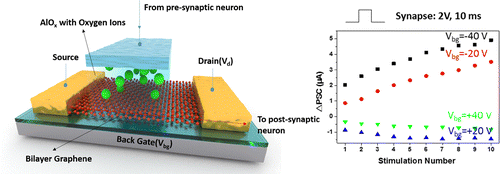Imitating synapses of the human brain could lead to smarter electronics

Making a computer that learns and remembers like a human brain is a daunting challenge. The complex organ has 86 billion neurons and trillions of connections—or synapses—that can grow stronger or weaker over time. But now scientists report in ACS' journal Nano Letters the development of a first-of-its-kind synthetic synapse that mimics the plasticity of the real thing, bringing us one step closer to human-like artificial intelligence.
While the brain still holds many secrets, one thing we do know is that the flexibility, or plasticity, of neuronal synapses is a critical feature. In the synapse, many factors, including how many signaling molecules get released and the timing of release, can change. This mutability allows neurons to encode memories, learn and heal themselves. In recent years, researchers have been building artificial neurons and synapses with some success but without the flexibility needed for learning. Tian-Ling Ren and colleagues set out to address that challenge.
The researchers created an artificial synapse out of aluminum oxide and twisted bilayer graphene. By applying different electric voltages to the system, they found they could control the reaction intensity of the receiving "neuron." The team says their novel dynamic system could aid in the development of biology-inspired electronics capable of learning and self-healing.
More information: He Tian et al. Graphene Dynamic Synapse with Modulatable Plasticity, Nano Letters (2015). DOI: 10.1021/acs.nanolett.5b03283
Abstract
The synaptic activities in the nervous system is the basis of memory and learning behaviors, and the concept of biological synapse has also spurred the development of neuromorphic engineering. In recent years, the hardware implementation of the biological synapse has been achieved based on CMOS circuits, resistive switching memory, and field effect transistors with ionic dielectrics. However, the artificial synapse with regulatable plasticity has never been realized of the device level. Here, an artificial dynamic synapse based on twisted bilayer graphene is demonstrated with tunable plasticity. Due to the ambipolar conductance of graphene, both behaviors of the excitatory synapse and the inhibitory synapse could be realized in a single device. Moreover, the synaptic plasticity could also be modulated by tuning the carrier density of graphene. Because the artificial synapse here could be regulated and inverted via changing the bottom gate voltage, the whole process of synapse development could be imitated. Hence, this work would offer a broad new vista for the 2D material electronics and guide the innovation of neuro-electronics fundamentally.
Journal information: Nano Letters
Provided by American Chemical Society


















